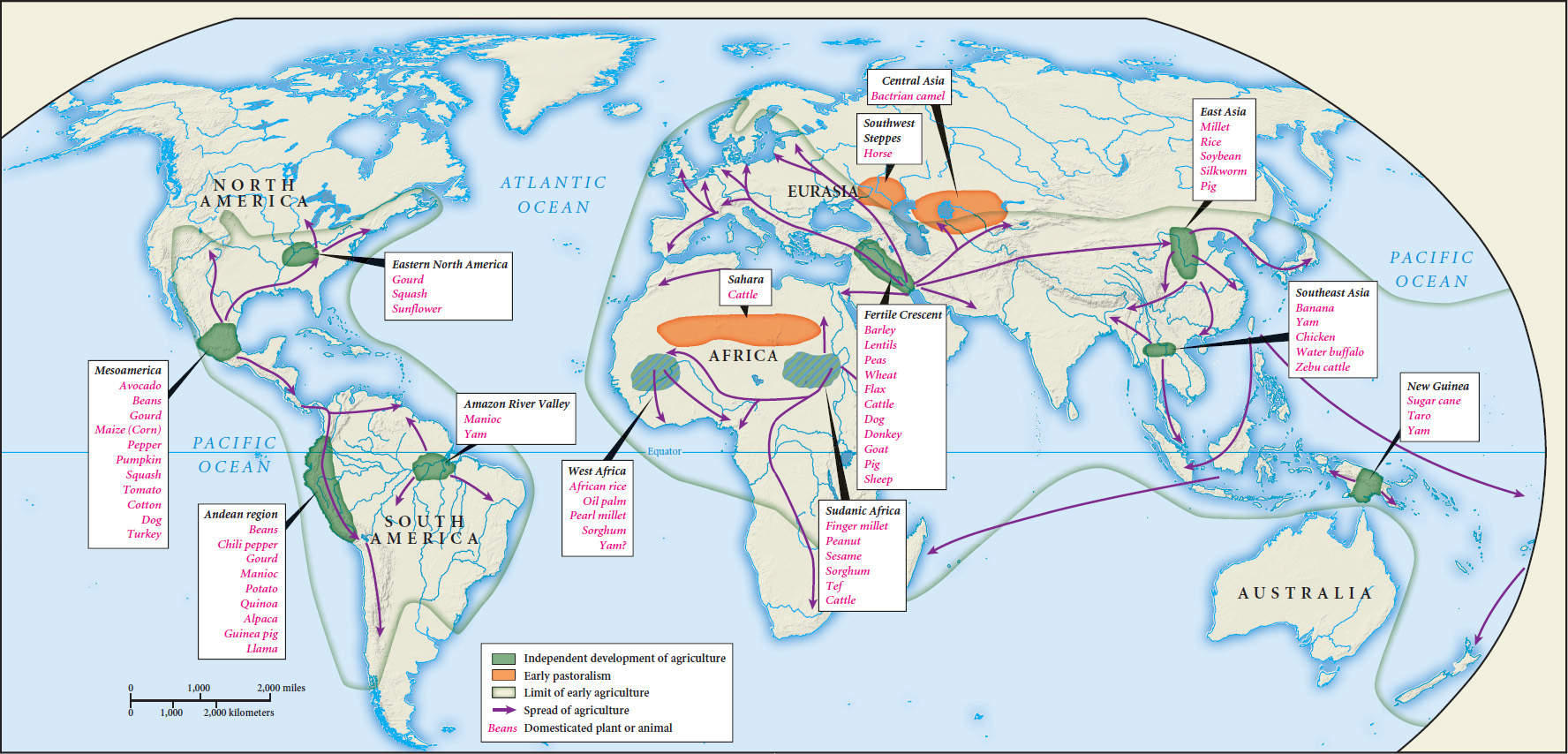Common Patterns
Perhaps the most extraordinary feature of the Neolithic or Agricultural Revolution was that it occurred, separately and independently, in many widely scattered parts of the world: the Fertile Crescent of Southwest Asia, several places in sub-Saharan Africa, China, New Guinea, Mesoamerica, the Andes, and eastern North America (see Map 1.3). Even more remarkably, all of this took place at roughly the same time (at least as measured by the 250,000-year span of human history on the planet)—between 12,000 and 4,000 years ago. These facts have generated many questions with which historians have long struggled. Why was the Agricultural Revolution so late in the history of humankind? What was unique about the period after 10,000 B.C.E. that may have triggered or facilitated this vast upheaval? In what different ways did the Agricultural Revolution take shape in its various locations? How did it spread from its several points of origin to the rest of the earth? And what impact did it have on the making of human societies?

Change
Question
What accounts for the emergence of agriculture after countless millennia of human life without it?
[Answer Question]
It is no accident that the Agricultural Revolution coincided with the end of the last Ice Age, a process of global warming that began some 16,000 years ago. By about 11,000 years ago, the Ice Age was over, and climatic conditions similar to those of our own time generally prevailed. This was but the latest of some twenty-five periods of glaciation and warming that have occurred over the past several million years of the earth’s history and that are caused by minor periodic changes in the earth’s orbit around the sun. The end of the last Ice Age, however, coincided with the migration of Homo sapiens across the planet and created new conditions that made agriculture more possible. Combined with active hunting by human societies, climate change in some areas helped to push into extinction various species of large mammals on which Paleolithic people had depended, thus adding to the pressure to find new food sources. The warmer, wetter, and more stable conditions, particularly in the tropical and temperate regions of the earth, also permitted the flourishing of more wild plants, especially cereal grasses, which were the ancestors of many domesticated crops. What climate change took away with one hand, it apparently gave back with the other.
Over their long history, gathering and hunting peoples had already developed a deep knowledge of the natural world and, in some cases, the ability to manage it actively. They had learned to make use of a large number of plants and to hunt and eat both small and large animals, creating what archeologists call a “broad-spectrum diet.” In the Middle East, people had developed sickles for cutting newly available wild grain, baskets to carry it, mortars and pestles to remove the husk, and storage pits to preserve it. Peoples of the Amazon and elsewhere had learned to cut back some plants to encourage the growth of their favorites. Native Australians had built elaborate traps in which they could capture, store, and harvest large numbers of eels.
In hindsight, much of this looks like a kind of preparation for agriculture. Because women in particular had long been intimately associated with collecting wild plants, they were the likely innovators who led the way to deliberate farming, with men perhaps taking the lead in domesticating animals. Clearly the knowledge and technology necessary for agriculture were part of a longer process involving more intense human exploitation of the earth. Nowhere was agriculture an overnight invention.
Using such technologies, and benefiting from the global warming at the end of the last Ice Age, gathering and hunting peoples in various resource-rich areas were able to settle down and establish more permanent villages, abandoning their nomadic ways and more intensively exploiting the local area. In settling down, however, they soon lost some of the skills of their ancestors and found themselves now required to support growing populations. Evidence for increasing human numbers around the world during this period of global warming has persuaded some scholars that agriculture was a response to the need for additional food, perhaps even a “food crisis.” Such conditions surely motivated people to experiment and to innovate in an effort to increase the food supply. Clearly, many of the breakthroughs to agriculture occurred only after gathering and hunting peoples had already grown substantially in numbers and had established a sedentary way of life.
Göbekli Tepe in Turkey provides a possible example of the process. Klaus Schmidt, the chief archeologist at the site, argues that the need for food to supply those who built and maintained this massive religious complex may well have stimulated the development of agriculture in the area. Certainly, some of the earliest domesticated wheat in the region has been located just twenty miles away and at roughly the same date. If this connection holds, it suggests that the human impulse to worship collectively in a village-based setting played a significant role in generating the epic transformation of the Agricultural Revolution.
These were some of the common patterns that facilitated the Agricultural Revolution. New opportunities appeared with the improved climatic conditions at the end of the Ice Age. New knowledge and technology emerged as human communities explored and exploited that changed environment. The disappearance of many large mammals, growing populations, newly settled ways of life, and fluctuations in the process of global warming—all of these represented pressures or incentives to increase food production and thus to minimize the risks of life in a new era.19 From some combination of these opportunities and incentives emerged the profoundly transforming process of the Agricultural Revolution.